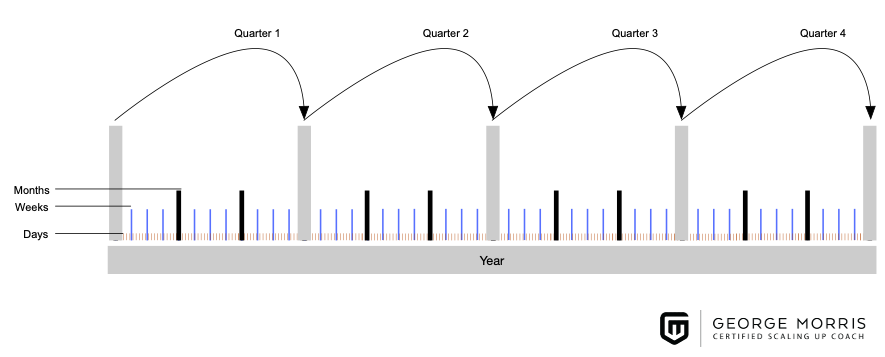I love meetings.
Yes, you read that right. I LOVE meetings.
I realize most of you have perfectly justifiable reasons you dislike them. Too many meetings in a given week. Meetings break the flow of the day. Priorities are often unclear. Meeting attendees are busy covering their asses or deflecting blame and responsibility. At the very worst, it's a one-way conversation of things needing to get done.
In the Scaling Up methodology, we elevate the importance of a meeting cadence. As Scaling Up Founder Verne Harnish says, "a good meeting cadence is the heartbeat of an organization." When executed appropriately, meetings are fantastic gatherings of talented, aligned, and curious team members. A healthy company has five types of meetings:
- Daily - Tactics/Communication
- Weekly - Priorities/Debate
- Monthly - Big Issues/Knowledge Transfer
- Quarterly - Planning/Focus
- Yearly - Strategic Rethinking/Planning
A clear meeting structure creates a cadence.

Each type of meeting has its own set of timely and relevant data to review, issues to be addressed, and actions to be taken. For instance, during a 4D Weekly Meeting (L10 in the EOS Traction world), your team wouldn't review the monthly financials from the previous month. That data set would be reserved for review during the Monthly Meeting, or the 2D Meeting, for "Deep Dive." Likewise, weekly sales figures wouldn't wait for the 2D Meeting. Those would be best reviewed during the Weekly, where the team can make adjustments to leading indicators.
Much has been written about Daily Huddles, Weekly Meetings, Quarterly and Yearly planning, yet I've noticed a gap in the Monthly Meetings. Here is my template on how to think about the Monthly Meeting in a format that I call the 2D or "Deep Dive."
What's the intent of these Deep Dive/ 2D Meetings?
To make ample time each month to intensely discuss significant issues in the company. It's a chance for the Executive Team to prepare thoughts in advance, hash out thorny topics and make headway on the long-term issues that have built up between meetings.
A sample agenda with guiding questions looks like this below. Be sure to identify who on your team will be the Facilitator prior to the meeting. It's their job to keep the discussion on track.
- One Word Open - 2 min
- Personal and Business Highlight of the Last 4 Weeks - 6 min. Go around the room and everyone participates in giving the two highlights. Reflect on the most meaningful items to share looking back a month.
- DNA Review - 10 mins. Take the time to step back and contextualize priorities and Rocks. During this 10 min period, review the BHAG, Goals, 7 Strata, Core Values, etc. If everything still resonates, great! If no, put it into your issues list to discuss it more.
- Monthly Data Review - 20 mins. Walk through each of the monthly metrics. Each Owner takes turns fielding questions and observations from the team. If an item will take longer than a few minutes to address, move it to Long-Term Issues. Review the monthly metrics well before the meeting. Bring notes and questions to the conversation. This isn't a presentation. It's a time for adding clarity.
- Process Evolutions - 30 to 60 mins. Each Core Process (PACe) owner reviews their KPIs for their process. These questions help guide the process review:
- Where is your team repeatedly stuck?
- What is your team telling you?
- How can you tell if the process is being followed?
- Where do you see an opportunity to improve the process?
- Accountability Evolutions - 30 mins. Each member of the Executive Team checks off their direct reports. The questions to review are:
- Do you have the right people in the right seats? If not, how do you plan to address it?
- Are your team meetings effective and necessary?
- What patterns are coming up repeatedly that need to be addressed?
- Long-Term Issues - 180 mins. Go through the Long-Term Issue list. Re-sort the list in the priority that makes the most sense.
- Conclude and Rate - 10 mins. Recap all actionable to-dos with dates, owners, and clear measures for success or completion. Then each member scores the meeting from 1 to 10.
I'd encourage you to use this template in your next Monthly Meeting to make it a 2D Meeting. If you do, I'd love to hear your suggestions for changes or what worked well for you and your team.

